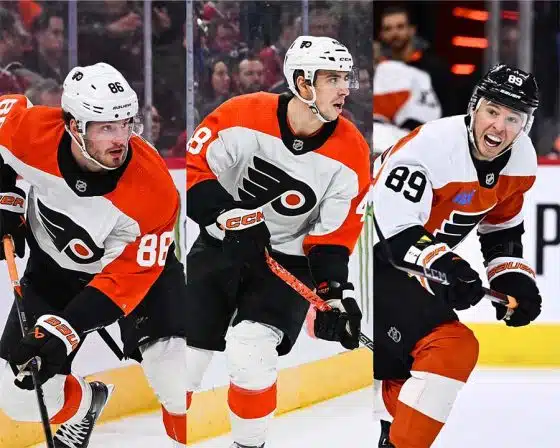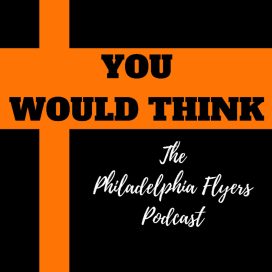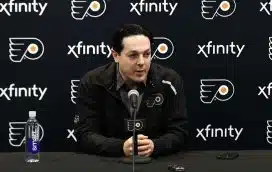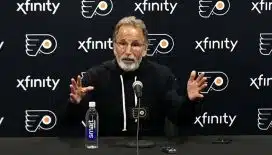By Kevin Durso, Sports Talk Philly editor
Eric Lindros burst onto the scene as a 19-year-old with a ton of potential. And it was quickly potential realized for the Flyers.
From the beginning, Lindros was a fan favorite and a star in Philadelphia. But quickly Lindros and his popular No. 88 came to define the Flyers teams of the 1990s. By the middle of the 90s, Lindros was not only the face of the Flyers, but a face of the NHL too, right up there with the likes of Wayne Gretzky and Mark Messier, Mario Lemieux and Jaromir Jagr, Steve Yzerman and Brendan Shanahan and Peter Forsberg and Joe Sakic.
At the peak of his career in prime health, Lindros was as good as anyone. Unfortunately, injuries derailed his career and slowly the potential that was slipped away.
But during the heart of it, Lindros was recognizable as any, and a lot of it had to do with an iconic number that was all his own. Chances are if you see a player wearing No. 88 today, Eric Lindros had something to do with it. And the number defined not only Lindros' career, but an era of Flyers hockey.
Acquiring a top prospect, as Lindros was, created a buzz in Philadelphia. And when Lindros followed with the numbers, creating instant chemistry on a line with Mark Recchi and Brent Fedyk, he was off and running.
Lindros probably would have been a Calder Trophy finalist if not for missing time with a knee injury and a record-setting rookie year from Teemu Selanne. Lindros only played in 61 games in the 1992-93 season, but had 41 goals and 75 points.
The following season, Lindros played in 65 games and scored 44 goals and 97 points, making his first All-Star Game.
But the lockout-shortened 1994-95 season was Lindros breakthrough. He scored 29 goals and had 70 points in 46 games and took home the Hart Trophy as the league's most valuable player. In the playoffs, the Flyers reached the Eastern Conference Finals, falling to the New Jersey Devils, but Lindros' early playoff success put him on a national stage.
It was during the 1994-95 season that the Flyers made a move that would send the franchise on their way to years of playoff appearances and near-misses at a Stanley Cup. The trade with Montreal that brought John LeClair and Eric Desjardins to Philadelphia, even while sending Mark Recchi to Montreal, established the Legion of Doom. Along with Mikael Renberg, Lindros and LeClair became a duo that made regular All-Star appearances and put up astounding numbers.
Lindros and company put together another Stanley Cup run in 1997, reaching the Stanley Cup Final before being swept by the Detroit Red Wings. That was as close as they would ever get.
The Flyers once again reached the Eastern Conference Finals in 2000, with Lindros having been in and out of the lineup battling injuries, notably the concussions that would ultimately derail his career. He suffered his final one in Game 7 of that series, as a crushing hit from Scott Stevens sent Lindros to the ice. The Flyers had a 3-1 lead in the series, but fell to the Devils in seven games.
After that game, the falling out between Lindros and the Flyers hit a breaking point. Lindros did not play in the entire 2000-01 season, and was finally traded in August 2001 to the New York Rangers, ending a saga that spanned for over a year in a rather depressing manner.
It wasn't until New Year's Eve 2011, when Lindros returned in the Orange and Black for the Winter Classic Alumni Game that the past seemed to finally go behind all parties. Lindros was warmly received by the fans, the game was a hit and Lindros was back as a regular participant in alumni events.
In the middle of it all, whether it was the Crazy Eights line with Recchi and Fedyk or the Legion of Doom with LeClair and Renberg, No. 88 was at the center of it all.
Another thing that made Lindros so easily identifiable was the 'C' on the front of the jersey to go along with the number on the back. Lindros was the 11th captain in Flyers history, and held the 'C' for six seasons, starting in 1994-95. Only three other Flyers captains have held the role longer — Bobby Clarke twice for a span of nine seasons, Dave Poulin for six seasons and current captain Claude Giroux, in his sixth season as captain.
Throughout his career, Lindros was a consistent goal scorer. While he never reached the 50-goal mark in a single season, his career high was 47 goals in 1995-96 and scored at least 30 goals in six of his eight seasons with the Flyers. He only failed to reach 30 goals in 1994-95, when he scored 29 in a lockout-shortened 46 games, and his final year with the Flyers in 1999-2000, when he scored 27 in 55 games.
Lindros also posted at least 70 points in each season except his last with the Flyers, when he had 59 points in 55 games.
What made Lindros so unique was that a player of his size and physicality which embodied the Flyers so well was accompanied by great hands and excellent puck skills. Lindros was as skilled and silky smooth with the puck as he was physical and tough.
One thing remained constant throughout. Lindros' No. 88.
When the Flyers retire the number on Thursday night, it will officially be Lindros' number forever. But unlike the other Flyers who have their number retired, Lindros stands alone as the only player in the 51-year history of the Flyers to ever wear the number.
It was a number that became quite popular over nearly a decade of Flyers hockey from when Lindros first landed in Philadelphia and ever since, it has stuck.
So the number that defined nearly a decade of Flyers hockey, and continues to be a reminder of those teams from the 90s, takes its place with the other greats in the rafters. Eric Lindros was forever going to be No. 88. And after Thursday night, there will be a physical reminder in the Flyers home arena as well.







